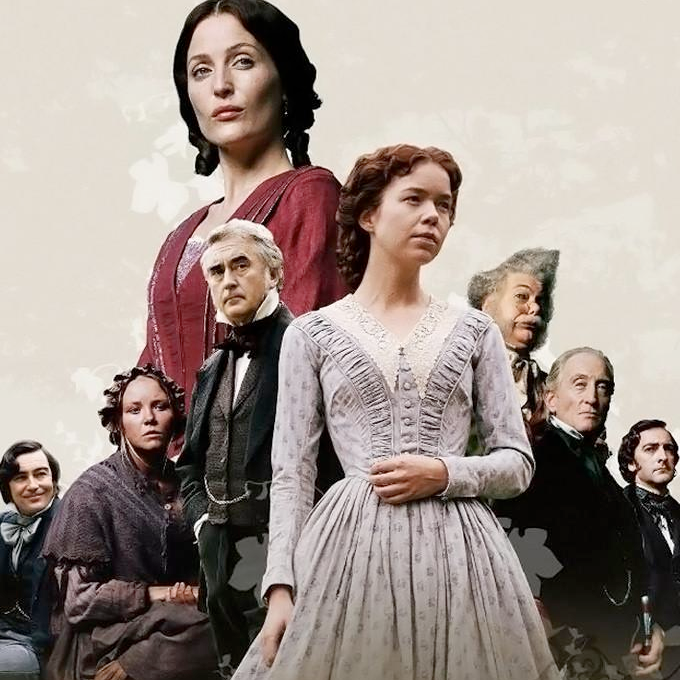
The Characters of Bleak House, BBC, 2005.
An alarming amount of my time as a graphic designer and art director is spent dissuading clients from taking the safe option. This doesn't come from a desire to be radical for the sake of being radical. Instead, it comes from a pragmatic conviction that success in most forms of communication (commercial and non-commercial) is best achieved by crediting audiences with intelligence, and avoiding clichés and formulaic gestures. But this is a hard argument to win. Brave clients are rare; there is security in sameness, and safety in dumbing down. Of course, dumbing down extends beyond the sheltered groves of graphic design: for countless activities, dumbing down is now the default position.
Scanning the cultural landscape for suitable examples to demonstrate that dumbing down is unnecessary, is often fruitless. Good specimens are difficult to find, especially for graphic designers (there are only so many times that you can wave a Dutch design book in front of a client.) Yet a surprise candidate has appeared on the British scene. Who would have guessed that a BBC costume drama would provide us with Exhibit-A in the defense's case —that a mass audience can be engaged without pandering to base instincts?
The BBC's current serialisation of Charles Dickens' Bleak House is a triumphant example of mainstream entertainment that has style and integrity, and is devoid of patronising tones: it's Dickens at his effervescent best — a thousand-page masterpiece of ravishing invention with enough darkness (and macabre horror) to keep James Ellroy fans transfixed, yet sufficient romantic sentiment to melt all but the most stoney-hearted. With unexpected verve, the BBC has taken this epic novel and parsed it into fifteen, twice weekly, half-hour episodes. The £8m ($14m) production is broadcast during prime time on Thursday and Fridays — during peak-viewing slots normally reserved for soap operas, quiz shows and other types of standardised entertainment.
The BBC has a long tradition of producing well-crafted costume dramas. But Bleak House is something entirely different. The scriptwriter Andrew Davies has taken a forensic eye to Dickens' book and distilled it into a series of pared-down, dramatically-charged episodes. His script has been brought vividly to life by two directors, and the art direction brilliantly transforms London into a kind of Victorian-era Blade Runner. The acting is consistently strong, notable for some unexpected casting choices: the X-Files' Gillian Anderson, for example, plays the female lead with impeccable aristocratic hauteur. Dazzling camera work makes the series feel at once dynamic and relevant by contemporary production standards, and the editing uses, to surprisingly good effect, the sorts of fashionable slam cuts more commonly found in music videos. Apart from a lacklustre title sequence (surely some of the budget could have been spent on graphic design?) the production is practically flawless.
Though historically accurate, this is not a snooty, over-precious reworking of Dickens. It's vibrant and engaging, and — like Dickens himself — shamelessly populist. (Many off his novels were published in installments and the author promoted them with frequent public readings.) It is brilliantly scheduled and cleverly promoted, and as a consequence, has grabbed 29% of the UK viewing public.
To a global audience, the fact that the BBC has produced 15 episodes of high-quality costume drama will hardly raise an eyebrow. For most people around the world, the BBC is a paradigm of quality and integrity; indeed, serialisations of such classic novels are precisely what the public has come to expect. Yet for the British TV viewing audience, our sense of the BBC is different. The 'Beeb' still beats most of its commercial rivals for programming excellence and range of content, and we still turn to it instinctively at moments of national crisis. But in recent years, it has become drearily keen to serve up far too much dross for no reason other than to crow about its share of the viewing audience.
But why should the BBC chase ratings? After all, it is owned by the nation and paid for by a levy (the license fee) charged to every UK household that owns a television set. It is a genuine public-service broadcaster. Yet paradoxically, it's the BBC's public sector status that has led to its ratings-obsessed drift toward dumbed-down broadcasting. So great is the fear that a free-market inclined government will revoke the Corporation's charter and cut it adrift to survive in the open market, that the BBC has felt compelled to insure against this eventuality by ratcheting up its viewing figures by whatever means possible.
The UK government is currently reviewing the BBC's charter, and for some observers, the corporation's courageous dramatisation and daring scheduling of Bleak House is a calculated and cynical act of self-preservation. What better way to show the policy-makers that the BBC is still committed to first-rate public service broadcasting than to stage a prime-time dramatisation of one of the classics of English literature?
This may be the case, but it doesn't negate Bleak House's contribution to the dumbing down debate. A more effective rebuttal of the notion that dumbing down is a prerequisite of attracting a mass audience will be hard to find.


Comments [12]
When the U.S. Public Broadcasting System wants to show relevancy to Congress they need to show that they have the same conservative blowhards as you have on Murdoch's Fox News. To keep the pledge dollars rolling in (and to show relevancy to the donors), they show horrible shows like ariel photography of the British Isles or reunion concerts of has been folk acts.
Nothing would end PBS's 30-year run as quickly as staging as a high-dollar Dickens dramatic extravaganza!
12.19.05
05:53
12.20.05
12:21
Good thing this doesn't happen in the creative world. Ever wonder why there are titles like "senior creative director" or "senior art director"? It's all based on the premise that people need to be managed, especially their creativity. Why? Because we've been dumbed down. We need to be "directed" and "supervised" in our creative activities. We can't be trusted to be creative on our own. How many "approval" chains do we go through with our concept developments? Would we ever dare showing something to a client without our "management" okaying it?
An "Art Director" friend of mine at an agency told me how he wasn't "invited" to be on the creative team for an interesting new project. Why? Because his creative team boss said he "wasn't ready yet." Instead he was stuck cranking out mundane but billable projects for clients. Hmmm. Was Charles Lindbergh ready to make the first solo trans-Atlantic flight in history at age 25 having very little flying experience? Was Bill Gates ready to start Microsoft when he couldn't even finish college? I think you get the point. Structures like these are created and maintained to ensure a class and pay system (no, I'm not a communist), not to nurture creativity. They don't just keep people down, they keep creativity down too.
Have you ever met two people who were alike? I haven't. Have you ever seen two designs that are alike? I have...lots of them (just look at my own work). Ever wonder why creative people who are all so incredibly unique can produce such a pile of bland sameness in design? Wouldn't it follow that if the individuals are all unique, their designs would all be unique as well? So what happened? Management. Supervision. Direction. These structures dumb us down creatively and have been doing so since we were kids in school being taught to color between the lines. Relationships. Freedom. Passion. These are the things that produce unique creative work and allow those brief breakthroughs of form with meaning like the BBC series.
12.20.05
09:09
12.21.05
01:23
Here's another thought:
Does "marketing" dumb down "design"? On many an occasion, I would say yes.
"Design" makes Che Guevara an international icon
"Marketing" results in the frat boy with the Che t-shirt and "GIT-R-DONE" hat, all in the same ensemble. (sadly this isn't a hypothetical example).
12.21.05
11:32
12.21.05
03:36
I have always been a staunch advocate of design as it exists outside of marketing/advertising. Thanks for the links, they are great resources.
12.21.05
04:42
It certainly seems like program directors at the Beeb have continued reading their Chesterton, and taking careful notes.
12.21.05
11:19
Before you jump on the WASP hating, Republican-hate-machine bandwagon, know this: American companies are shell-shocked from these suits, which is why when you buy a bucket in California it specifically has a giant warning about not letting your baby drown in the bucket. Don't believe me? Look at some 5 gallon buckets at a big box store, chances are that it'll be there, whether it contains butter or paint - no matter where you live in the US.
Look at McDonalds. They have gi-normus warnings on their coffee cups now, and I think we all can remember why.
Then there are tides of really ridiculous little lawsuits like the one where a fella is suing a very large company because even though the packaging says only 'assembled in U.S.A.' he feels cheated when he found a bonus (as in free) component is actually made in Chile. BTW: he's a lawyer by trade.
This is what they are up against. They are constantly trying to cover their butts and hopefully sell something. I have seen it take a MONTH to craft a few sentences so they pass through legal.
I have been trying to champion the idea of, lets call it, 'customer pull' rather than 'customer push' since I started in this industry. Personally, I believe you can assume that someone will know what a paint brush is without having to label it 'paint brush' as I am sure that a device such as this has been nearly the same for over 3000 years. I still was out-voted. Most prefer the 'customer push' model where everything is spelled out at 3rd grade reading level, making sure EVERYTHING is explained and run past legal. They don't think we're dumber than previous customers, they are now making things for the .05% of customers who buy to sue.
The other, albeit smaller, reason is the relative speed at which communication must happen. In Home Depot, we figure that a person with an unencumbered path will cross a gondola in something like 1.4 seconds. That's not very much time to impart a message. People have learned to try and get it down to one or two words that everyone understands. We can't say 'Generously appointed with lavish ornamentation for the discerning customer' we say 'We've got your stuff.' so no-one is confused or left out nor can it mean we're selling something we're not.
But it all comes to pocketbooks in this country so vote with them! You out there with Nielsen boxes, keep watching the interesting shows, like Arrested Development, Globe Trekker and others who break the mould. Perhaps someday, we'll change the perceptions.
Hope this insight helps!
ef
12.22.05
05:30
12.31.05
06:43
01.01.06
03:45
01.08.06
12:53